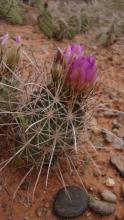Native to the Colorado Plateau Province of the western United States. Winter wet sensitive but cold hardy with great long hooked spines. It grows well for me. Sclerocactus parviflorus flowers come in various colors usually rose to purple, pink, there are also multicolour, yellow, white.
Comments
Re: Sclerocactus parviflorus
John, I recommend that you click on the Profile tab (in the upper left portion of the screen), then in the Modify Profile options on the left, select "Forum profile information", then in the Signature box, enter in some "signature block" information... that information will show up at the bottom of every message you post... so be sure to include your general geographical vicinity, USDA zone, and your name, etc, that will help people know to to gauge plant culture info and provide more context for responses. Once you've entered signature info, click on Change Profile at the bottom right, then you should be all set. :D
Re: Sclerocactus parviflorus
Very nice species, John. And well grown, too!
Re: Sclerocactus parviflorus
You have an unusually nice form of this super plant: you are at least a week, and maybe more, ahead of Denver: my Scleros are in bud still (except for Sclerocactus papyracantha, which is blooming). For those in maritime climates, you will be challenged to grow these. Even Denver is too wet! (I grow mine in containers: a few locals grow them in the ground in xeric gardens, but every few years we get a little too wet and they rot.) Almost all species in the genus grow in areas with less than 10" precipitation a year, and usually on very fast draining mineral soils. They are not for the faint of heart to attempt.
I led a field trip for Denver Botanic Gardens to the Moab area the last week of April for six days with 17 participants: we ended up doing some "homework" for the research department at Denver Botanic Gardens which is doing DNA analysis on Sclerocacti in the west: so we had permits from BLM and collected buds on 30 individuals of Sclerocactus parviflorus at one locality where it was especially abundant. Since this is the largest barrel cactus in much of the interior US, it is subject to depredation, unfortunately, by ignorant gardeners. Scleros shoudl really never be collected, nor is their need to. Seed is widely available, and plants are sold by Mesa Gardens and others occasionally. Fortunately, this species is so widespread and common still I don't think it's vulnerable, but many Sclero species are. They are cult plants in Germany now,where they are grafted onto Opuntias, I think...for those suckers for punishment, you can see a slide show of this trip at: http://s979.photobucket.com/albums/ae272/kelaidis/Moab%202010/?albumview... (oh yes, Mark: you can help me ID the two Allums!)
Re: Sclerocactus parviflorus
PK
Very impressive spines on your plant. I like it!! ;D
Re: Sclerocactus parviflorus
Awesome slide show! Is Penstemon utahensis amenable to cultivation? What a stunning species it is. The first views of a white allium might be A. macropetalum, but I would need to go back to the photobucket album and look more critically. Mahonia fremontii also made an impression on me. Since everyone had their photo taken with that magnificent Echinocereus coccinea, how come we didn't see you or Ted posing with it ;D
Re: Sclerocactus parviflorus
Mahonia fremontii also made an impression on me.
Mark
It makes an impression on me in my garden every time I kneel on one of it's shed leaves. :o :'( >:(
Re: Sclerocactus parviflorus
Glad you guys liked the Scleros. Moab is awesome in the spring!
Gotta get ready: garden party Saturday and kickoff tonight with volunteers...things looking good!
Re: Sclerocactus parviflorus
Mahonia fremontii also made an impression on me.
Mark
It makes an impression on me in my garden every time I kneel on one of it's shed leaves. :o :'( >:(
That's why one of my gardening rules, is to not plant anything pokey or spiny in the general garden. Finally dug up and threw out a dwarf carpetting Rosa cultivar (I forget its name) that was given to me, as I'm sick if getting jabbed by this thorny rambler. If I do grow cacti, and I surely hope to, they'll be in troughs or large planters where they can safely revel in their spiny exuberance.
Re: Sclerocactus parviflorus
If I do grow cacti, and I surely hope to, they'll be in troughs or large planters where they can safely revel in their spiny exuberance.
Mark
Are Opuntias on your list? If so good luck with that!! Those glochids will find a way to get you! Like it or not!
Re: Sclerocactus parviflorus
Mark
Are Opuntias on your list? If so good luck with that!! Those glochids will find a way to get you! Like it or not!
I only have a small O. humifusa in a planter. Maybe I should just admire Opuntia phtographically... hate glochids. It's bad enough cleaning up around Onosma species, that have glochid-like tendencies, where gloves must be used to avoid skin irritations. And now that I'm growing a comprehensive collection of Epimedium, some of the Asian species have spiny leaves, soft enough when in fresh growth, but tough and very prickly on mature leaves and when dried... just jabbed myself on Epimedium campanulatum when weeding around it yesterday.
Re: Sclerocactus parviflorus
I do not grow Opuntia either. No "removable" spines for me. Although, If I could find a cholla that's hardy here, I might rethink my rule.
Re: Sclerocactus parviflorus
Rick
The only cholla that stands a chance for you would be imbricata or just maybe a low growing whipplii. Just keep them dry in the winter. They are more tolerant of cold weather if keep dry.
If you want to give it a shot private message me. I know were you can get a cutting or two. 8)


Nice! One comment...when you say it grows well for you, it would be nice to know where you are.